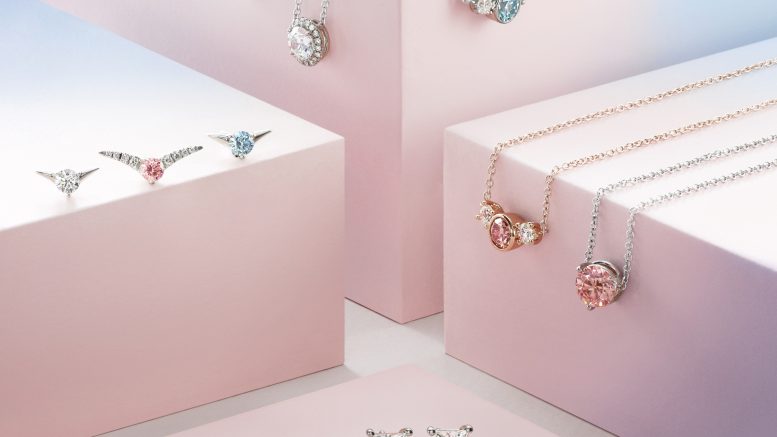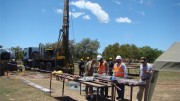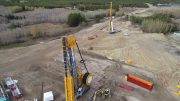Scrolling through the website of Lightbox Jewelry soon after its launch in late September, three things jump out at you.
First, the website declares its product is lab-grown diamonds.
Second, the pricing is consistent, regardless of the colour of the synthetic diamonds on offer (white, pink or blue) and surprisingly low. It also increases proportionally with size.
And third, there are no rings for sale – only earrings and necklaces.
Owned by diamond miner De Beers, Lightbox is clearly putting into action De Beers’ strategy for differentiating synthetic and natural diamonds in the minds of consumers.
When De Beers announced its new business in late May, some, like independent analyst Paul Zimnisky, called the move “genius,” while others, like JCK news director Rob Bates, called it a “huge gamble.”
In a release, the company said that it aimed to provide affordable, high-quality fashion jewelry to consumers.
“Lightbox will transform the lab-grown diamond sector by offering consumers a lab-grown product they have told us they want but aren’t getting: affordable fashion jewelry that may not be forever, but is perfect for right now,” De Beers Group CEO Bruce Cleaver said.
“Our extensive research tells us this is how consumers regard lab-grown diamonds — as a fun, pretty product that shouldn’t cost that much — so we see an opportunity here that’s been missed by lab-grown diamond producers.”
But De Beers is also entering the space to educate customers and differentiate lab-created diamonds from its main product — mined diamonds.
“We’ve learned from our research that there is a lot of confusion about lab-grown diamonds – what they are, how they differ from diamonds and how they are valued,” said Steve Coe, general manager of Lightbox Jewelry. “Lightbox will be clear with consumers about what lab-grown diamonds are and will offer straightforward pricing that is consistent with the true cost of production.”
In an interview, De Beers Canada CEO Kim Truter said that the rise of labs making and selling synthetic diamonds has created confusion both in the mid-stream of the business (cutters and polishers) and among customers.
At first, De Beers’ response was to focus on developing technology that could detect synthetics. But as labs proliferated, the company realized an additional response was required.
“What we decided to do as De Beers is to make sure that it was crystal clear in peoples’ minds the difference between a lab-grown stone, which is a very reproducible stone and we would argue is more of a commodity than a diamond, because as we all know, every single diamond is different,” Truter says.
“So the Lightbox announcement and the commercial go-live process is to clearly distinguish between the two and to make sure that the pricing differentiation between a natural mined stone and a synthetic stone is very clear, and that consumers can be well educated about the difference when they’re making a purchase.”
Pricing
As part of establishing a clear difference between lab-created and mined diamonds, De Beers is offering Lightbox jewelry for extremely competitive prices. In fact, the price of Lightbox stones — US$800 for a one-carat polished — is up to 80% less than its competitors’ prices, Zimnisky says.
“We’re talking substantial price undercutting,” he says. Through its Element Six subsidiary, De Beers has been creating synthetic diamonds for industrial use for over 50 years. The company says that after decades of R&D investment, it’s able to offer affordable prices for its lab-created stones while still making a profit.
Although De Beers is intentionally not selling diamond rings — which it would argue should be made with natural, mined diamonds — Zimnisky says this doesn’t mean individual consumers can’t buy a piece from the website and have it reset. (Only finished jewelry is available from the website.)
“That’s possible and it seems like there’s enough incentive to do that because the price is so much lower.”
As for Lightbox’s possible effect on mined diamond prices, most miners applaud De Beers’ strategy.
“We fully support what De Beers has done here,” said Stornoway Diamond (TSX: SWY) president and CEO Matt Manson.
“The whole idea of differentiating natural diamonds from synthetic diamonds by forcing the price of synthetics down, which is what Lightbox is, is a very clever idea. The diamond business has absolutely no problem with the Swarovski crystal business, for example, because even though we’re selling jewelry that’s white and sparkles, it’s a different market.”
That said, the price of lower-quality and smaller mined diamonds may be vulnerable to competition from synthetics.
“There is cause for concern there,” said Zimnisky. “The sub-US$1,000 diamond jewelry pieces are probably the pieces that are going to be most likely at risk of losing share to lab-created.”
However, most agree that a response to labcreated diamond jewelry was likely necessary to safeguard the natural industry. In that light, De Beers’ move to control the narrative will benefit all miners.
“I don’t think De Beers ever wanted to get involved in the lab-created diamond jewelry space,” Zimnisky says. “I think this was a result of necessity, given how far and how quickly the lab-created diamond jewelry industry is progressing. So I think this was more of a proactive — maybe offensive move on their part.”
Zimnisky says he believes there will be inherent support in the value of natural diamonds because the cost to produce is increasing while production costs for lab-created diamonds drop.
High-tech opportunity
Over the next four years, De Beers is investing US$94 million to build a facility in Oregon to support its Element Six facilities in the U.K. in producing Lightbox diamonds via chemical vapour deposition (CVD). The plant will be capable of making 500,000 carats of rough synthetic diamonds per year.
Until its Oregon facility is ready, Zimnisky says the company is essentially selling rejects from Element Six.
Compared to De Beers’ rough mined production of 30-35 million carats for 2018, Lightbox will be a small component of De Beers’ overall business — too small for parent company Anglo American (LSE: AAL) to detail in its financial reporting.
But that could change.
The “endgame” for the labs that have entered the synthetic diamond business is not jewelry, but the high-tech industry, Zimnisky says. Diamond’s thermal conductivity and ability to cool quickly make it ideal for many industrial applications. But to use diamonds in this way, industry would need access to perfectly flawless and consistent diamonds on a large scale.
De Beers’ technology could give it a head start in this market, which will be much larger than the jewelry market.
“For a company like Anglo, 10 or 20 years from now, what might be the most exciting outcome from this is that Element Six is the first player to really be able to produce very high-quality, lab-created diamonds on a large scale and start selling it to industry,” Zimnisky says.
That possibility could completely remake De Beers and Anglo.
“Can you imagine?” Zimnisky said. “In 2035, 2040, maybe it will actually make more sense for a multinational mining company to be generating a significant portion of their products from a synthetic material.”
— This article was first published in the November 2018 issue of Diamonds in Canada.





Be the first to comment on "De Beers launches Lightbox"